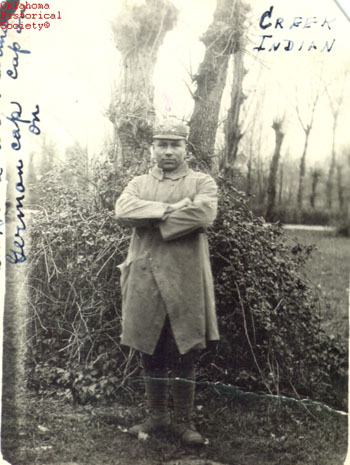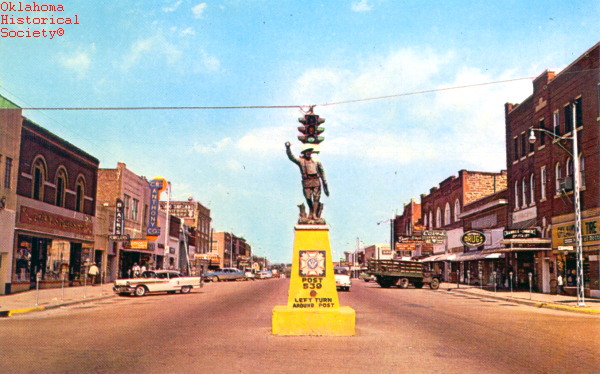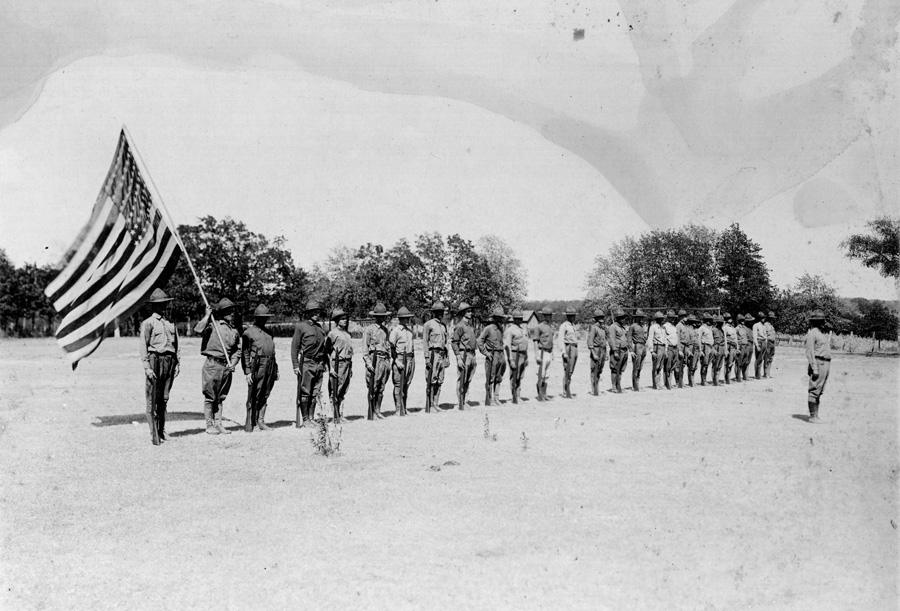
WORLD WAR I.
When World War I broke out in Europe in August 1914, most Americans responded in a deeply ambivalent way. Their initial response was that the United States must, at all costs, remain uninvolved in the conflict. As the presidential election of 1916 attests (when "he kept us out of war" became the centerpiece of Pres. Woodrow Wilson's successful reelection bid), most national leaders responded to this prevailing sentiment. Once the United States declared war on Germany in April 1917, however, public opinion on the conflict underwent a complete reversal, and Americans embraced the war effort with a ferocity that bordered on hysteria. Oklahomans' responses to the war between 1914 and 1918 were certainly consistent with this pattern. Indeed, it can be argued that the transformation from neutrality to "100 percent Americanism" was even more precipitous in the Sooner State than in the rest of the nation.
Oklahomans initially expressed a deep aversion to the war, an opinion compounded by the conflict's negative economic effect on the state. Germany's blockade of Allied ports effectively closed off valuable western European markets to American agricultural products, leading to a steep decline in crop prices. In Oklahoma, where agriculture was king, the results were disastrous. The month after the war began, the prices that Oklahoma's cotton farmers received for that commodity dropped more than 20 percent, from ten cents to eight cents per pound. Prices remained below the ten-cent mark for a full year, falling to six cents per pound in November 1914. Although the effect was not as direct for Oklahoma wheat farmers, prices for that crop remained below one dollar per bushel during 1914.
Elected officials in Oklahoma experienced firsthand their constituents' negative feelings about the war. U.S. Rep. William H. Murray, whose record as a political leader predated statehood, discovered in 1916 that his open support for war preparedness cost him his Fourth District congressional seat. Additional evidence of Oklahomans' lack of enthusiasm for the war came in 1917 when the U.S. Congress passed the Selective Service Act, which called for all men of draft age to formally register for conscription on a single day in June of that year. In June 1917 Oklahoma officials estimated the number of draft-age males in the state to be 215,000. Of that number, only 111,986 young men actually registered, and more than 80,000 of these claimed to be exempt from the draft. Thus, only 15 percent of the state's draft-age men indicated their willingness to fight in the European war. By war's end 59,247 white men and 19,999 African Americans had been inducted. Approximately 5,000 American Indians either enlisted or were inducted.
However, the economic crisis caused by the European war lessened Oklahomans' initial aversion to the conflict. As the United States moved closer to entering the war in late 1916 and early 1917, British and French markets were reopened, and American farmers became important suppliers to the Allies. The resulting increase in demand meant that for Oklahoma farmers the hard times of 1914 and 1915 were replaced by extraordinary prosperity. By December 1916 cotton farmers in the Sooner State were getting eighteen cents per pound for their crop (compared to just over six cents two years earlier), and prices would break the thirty-cent mark before the armistice in November 1918. The trend was identical for wheat farmers, who saw prices double between 1914 and 1918. When the United States formally declared war on Germany in April 1917, most Oklahomans were much more inclined to react favorably.
Some, however, still opposed American involvement. The most dramatic manifestation of antiwar sentiment came in Seminole and surrounding counties in August 1917 when rumblings of discontent with the war led to an uprising known as the Green Corn Rebellion. After seizing control of local institutions, the organizers of the uprising planned to travel to Washington, D.C., hoping to attract enough supporters on the journey to force the federal government to change its war policy. These plans never materialized, however, and the Green Corn Rebellion was easily put down by local authorities before the rebels left the state.
The Green Corn Rebellion and its aftermath helped spark a backlash against opponents of the war in Oklahoma. During 1917 and 1918 those who disagreed with American war policy were perceived as "radical" and "un-American," and the period was marked by unprecedented hysteria and the suppression of dissent. In this sense, developments in Oklahoma mirrored those in other states where federal officials used the recently enacted Espionage and Sedition Acts to prosecute approximately eighteen hundred antiwar dissenters. In addition, the federal government created a network of semiofficial watchdog organizations called the Councils of Defense to ensure the support of the citizenry for the war. In Oklahoma the council was directed by James Monroe Aydelotte of Oklahoma City, who presided over a network of county and local organizations dedicated to promoting loyalty and support for the war effort. Among other things, the Councils of Defense promoted the sale of war bonds, distributed loyalty pledge cards, and even reported to authorities the names of citizens who were less-than-enthusiastic in their support for the war. Given the kind of superpatriotism engendered by the Councils of Defense, especially the tendency to equate dissent with disloyalty, it is hardly surprising that at times the actions taken by these "patriots" took a decidedly extralegal form. Those identified as disloyal were often subjected to rituals of public humiliation (as the man in Comanche County, who was forced to publicly explain his refusal to sign a loyalty card and then to kiss the American flag) or violent intimidation (as happened to Robert Carlton Scott, Carl Albert's grandfather, who was given two hundred lashes by a mob for his refusal to sign a loyalty card).
In the end, the effect of World War I on Oklahoma was mixed at best. The increase in crop prices proved short lived. Soon after the war ended, Oklahoma farmers began suffering the effects of an agricultural depression. It would last for more than a decade, a crisis that was tied to the conflict's imperfect peace. Even more significantly, the use of intimidation to artificially limit the scope of political discourse proved to be one of the more enduring legacies of American involvement in the European war. Under such conditions the political dialogue shrank considerably as those holding positions considered to be outside of the mainstream were prevented from articulating them.
The results of the superpatriotism of 1917 and 1918 and the hysteria it engendered can be seen most clearly in the elections of 1918 and 1920. Faced with such a stringent narrowing of the public discourse, many Oklahomans simply retreated from the democratic process. Voter turnout in 1918 shrank by more than ninety-seven thousand, almost a third over 1916, and despite the fact that at least one hundred thousand voting-age males had come to Oklahoma since statehood, fewer males voted in 1920 than in 1907. In this sense, the events of 1917–19, known as the "First Red Scare," foreshadowed trends more commonly associated with the Cold War a generation later.










